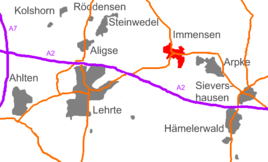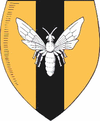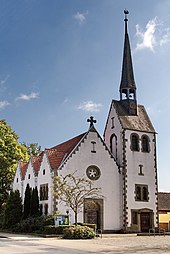Huge
|
Huge
City Taught
|
||
|---|---|---|
| Coordinates: 52 ° 23 ′ 45 ″ N , 10 ° 3 ′ 40 ″ E | ||
| Height : | 62 (61-67) m above sea level NHN | |
| Area : | 19.4 km² | |
| Residents : | 2412 (December 31, 2016) | |
| Population density : | 124 inhabitants / km² | |
| Incorporation : | March 1, 1974 | |
| Postal code : | 31275 | |
| Area code : | 05175 | |
|
Location of immense people in Lower Saxony |
||
|
Immense numbers in the urban area of Lehrte
|
||
Immensen is a district of the Mittelstadt Lehrte in the Hanover region of Lower Saxony .
geography
location
Immensen is located 26 km east of the state capital Hanover and 5 km northeast of the core city of Lehrter. The Immenser Pond is about 2 km to the southwest . To the southeast lies the Hämeler Forest and to the north the Burgdorfer Holz.
Neighboring places
| Stone fronds | ||

|
Arpke | |
| Taught |
history
First mention, incorporations
Immensen was first mentioned in a document in 1339.
Until the regional reform in Lower Saxony , which took place on March 1, 1974, Immensen was an independent municipality in the Burgdorf district , before it became a district in the city of Lehrte after its dissolution.
Population development
| year | 1885 | 1910 | 1925 | 1933 | 1939 | 1950 | 1956 | 1973 | 2010 | 2016 |
|---|---|---|---|---|---|---|---|---|---|---|
| Residents | 639 | 1067 | 1223 | 1177 | 1189 | 2424 | 2036 | 2264 | 2530 | 2412 |
| source |

|
politics
Local council
The local council of Immensen consists of two councilors and five councilors. There is also an advisory member (pirates) in the local council.
(Status: local election September 11, 2016)
Local mayor
The local mayor of Immensen is Falk Kothe (CDU). His deputy is Beate Julitta Lange (FWG).
coat of arms
The Immensen municipal coat of arms was designed by the heraldist and graphic artist Alfred Brecht , who designed all the coats of arms in the Hanover region. The approval of the coat of arms was granted on November 22, 1955 by the Lower Saxony Minister of the Interior .
| Blazon : "The coat of arms shows a black pole in the golden field , which is covered with a rising, silver bee (Imme)." | |
| Foundation of the coat of arms: In agreement with the family "von Gadenstedt zu Gadenstedt and Volkersheim", the coat of arms of this family, which according to documents was the owner of the Immensen Patrimonial Court from 1339 and 1341 to 1849, was chosen as the basis of the community's coat of arms. The flying, Silver Imme should again point to the popular interpretation of the name, but also apply in the deeper sense as a symbol of a biologically ordered community (compare the significance of the queen bee in the state). The Gothic form of the coat of arms was chosen to herald the old age of the basics of the coat of arms. |
Culture and sights
Buildings
- The St. Antonius Church in the middle of Immensen was built in the years 1877–1878 as a neo-Romanesque brick building by Conrad Wilhelm Hase . In 1899 the building was plastered.
- There are two memorials in the Bauernstrasse that commemorate the war dead. One from 1872 commemorates the dead in the First German-Danish War in 1848/51, the Prussian-Hanoverian War in 1866 and the German-French War of 1870/71. The second memorial from 1922 was erected in memory of those who fell in World War I and was expanded in 1958 to include more names of those killed in World War II .
sport and freetime
Sport mainly takes place in MTV Immensen. In addition to football, tennis, handball and running, it also offers a wide range of activities from children's gymnastics to gymnastics courses. The club life is very pronounced in immense numbers. There is an active rural youth group with a tradition going back more than 60 years, the Friends of Historic Vehicles and many other organizations.
There is also the Immensen e. V., in which small-bore rifles and air rifles are used. The practice of shooting sports can be documented in immense numbers up to the first half of the 18th century. For example, target shooting took place in 1732 , and a shooting festival is documented for 1829 . On this occasion, the court keeper von Gadenstedt donated the first flag for the Immenser Schützengesellschaft. From this company the Immensen rifle club was founded in 1931, which was dissolved by the military government in 1945 and re-established in 1949. After September 1949, the first shooting match after the Second World War had taken place, the club was new to the on 24 January 1950 Register of Burgdorf entered. The most successful club member so far in 2005 was the young Anna Riechelmann, who became national champion in small-bore shooting at a distance of 100 m and qualified for the 2006 German championship.
There is also the scout tribe "The Free Before the North Forest" of the Christian Scouting Association of Germany (1976) . Its work consists of conveying Christian values, contents of the scout work and elements of the German youth movement.
Regular events
Since 1987 the two-day open air music festival Zytanien has been taking place every year in August on the site of the former brickworks south of the village , on which three stages are now played.
Economy and Infrastructure
Companies
Immensen is characterized by agriculture. However, the majority of the agricultural businesses Immensens have fallen victim to the structural change in German agriculture over the past 25 years. From the former 52 farms, only a few sustainable businesses are left today. These have specialized in accordance with the requirements of the market and are managed from an entrepreneurial perspective. "Peasant agriculture" has almost completely died out here, as in many other places.
There are also some smaller commercial enterprises. The majority of the population works outside of the town.
traffic
Immensen is located on today's state road 412 between Arpke and Burgdorf and is connected to Lehrte via county road 134. The motorway junctions of the federal motorway 2 Lehrte-Ost and Hämelerwald are nearby.
Regular buses run to Lehrte and Burgdorf , Hämelerwald and Dollbergen .
The station Immensen-Arpke is located on the railway line Berlin-Lehrte in the northern part of Arpke at the former through road to Immensen. At the instigation of the two villages, it was initially built as a freight station for agricultural products and inaugurated on August 15, 1893; a passenger station was added later. The high-speed line Hanover – Berlin now runs through the station. The station is connected to Hanover and Wolfsburg by regional trains every hour . The station is in the tariff area of the Greater Hanover Transport (GVH). The old station building is now a private residence; ticket sales are guaranteed by machines.
Personalities
Sons and daughters of the place
- Heinrich Bokemeyer (1679–1751), cantor, poet and composer
- Otto Heineke (1893–1980), conservationist, art historian, teacher and farmer
- Otto Kloppmann (1902–1988), SS-Hauptscharführer and, as criminal secretary, head of the political department in the Majdanek and Dachau concentration camps
People connected to the place
- Conrad Wilhelm Hase (1818–1902), architect and university professor, he was considered one of the most important representatives of neo-Gothic of the 19th century, one of his works is the St. Antonius Church in Immensen, built from 1877 to 1878
- Adolf Meyer (1929–2018), long-time teacher and headmaster, local history researcher, author of a ten-volume local chronicle of Immensen and numerous other local chronicles, especially from the Celle district
- Norbert Herrmann (* 1943), mathematics professor at the University of Hanover , lived in Immensen
- Hiltrud Hensen (* 1948), third ex-wife of Gerhard Schröder and patron of various charitable organizations, lived in Immensen
- Lukas Rieger (* 1999), pop singer, lived in Immensen
Web links
Individual evidence
- ↑ a b c Population and territorial areas. (No longer available online.) In: Website Stadt Lehrte. December 31, 2016, archived from the original on June 19, 2018 ; accessed on July 14, 2020 .
- ^ Federal Statistical Office (ed.): Historical municipality directory for the Federal Republic of Germany. Name, border and key number changes in municipalities, counties and administrative districts from May 27, 1970 to December 31, 1982 . W. Kohlhammer, Stuttgart / Mainz 1983, ISBN 3-17-003263-1 , p. 222 .
- ↑ a b c d Michael Rademacher: German administrative history from the unification of the empire in 1871 to the reunification in 1990. Burgdorf district ( see under: No. 33 ). (Online material for the dissertation, Osnabrück 2006).
- ↑ Ulrich Schubert: Community directory Germany 1900 - Burgdorf district. Information from December 1, 1910. In: gemeindeververzeichnis.de. January 5, 2020, accessed April 1, 2020 .
- ↑ a b Statistisches Bundesamt Wiesbaden (ed.): Official municipality register for the Federal Republic of Germany - 1957 edition (population and territorial status September 25, 1956, for Saarland December 31, 1956) . W. Kohlhammer, Stuttgart 1958, p. 173 ( digitized version ).
- ↑ Lower Saxony State Administration Office (ed.): Municipal directory for Lower Saxony . Municipalities and municipality-free areas. Self-published, Hanover January 1, 1973, p. 35 , Burgdorf district ( digitized [PDF; 21.3 MB ; accessed on June 3, 2020]).
- ↑ Population and area areas. (No longer available online.) In: Website Stadt Lehrte. December 31, 2010, archived from the original on March 15, 2011 ; accessed on July 14, 2020 .
- ↑ a b List of local council Immensen. In: Website City of Lehrte. Retrieved August 25, 2017 .
- ^ A b Landkreis Hannover (ed.): Wappenbuch Landkreis Hannover . Self-published, Hanover 1985, p. 252-253 .
- ↑ List of names of those killed. In: Online project fallen memorials. Retrieved July 30, 2011 .
- ↑ Self-made chronicle of the shooting club Immensen e. V. (DOC; 36 kB) (No longer available online.) 2006, archived from the original on August 25, 2017 ; accessed on April 1, 2020 .
- ↑ Sport and Leisure. (No longer available online.) In: immensen.de. Archived from the original on February 29, 2016 ; accessed on July 15, 2020 .
- ↑ Henrik Jonas Günther: Pogo, Peace and Party in a mild summer night . In: Hannoversche Allgemeine Zeitung , Anzeiger für Lehrte . August 31, 2009, p. 5 .
- ↑ Erhard Strelow: Frederick the Great had his horses changed in Arpke. From the history of the former relay station . In: Lehrter Land & People. Magazine on history, culture and local history . Issue no. 10, autumn 1998, p. 26-28 .




